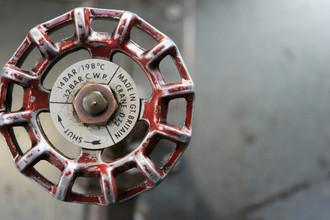Types of Valve Handles: Lever and Handwheels
Posted by Mark Trainer on Jan 29th 2024
Whether you're involved in industrial work, plumbing, or you're a DIY enthusiast, you come across valves all the time, which means you come across valve handles too. But how much do you know about a valves most visible feature? In this article, we explore the main two types of valve handles, and we also show when and why to use each type.
Basic Types: Lever Handle and Handwheel
Valves are opened and closed by either linear motion or rotary motion. Linear motion valves typically use lever handles. On the other hand, rotary valves usually have a handwheel, allowing an operator to turn the valve on or off. There are certainly exceptions. Sometimes a linear valve uses a handwheel, especially in large, industrial applications. True rotary motion valves cannot use a lever , but in some situations, a valve that is a rotary valve can be opened by a linear motion, typically because it is small. But enough with the exceptions, let's dive into the handles.
Lever Handle: the Quarter Turn Master
The lever handle is represented inthe ball valve handle and most butterfly valve handles too. All quarter-turn valves can use them as the handle is directly attached to the disk that regulates flow. A 90-degree turn is all it takes to change the flow from on to off. The handles are usually made from metals, typically stainless steel, or a tough plastic. The length and appearance of the lever handle can vary widely depending on the valve.

Apollo 87A-100 Ball Valve with a lever handle
Advantages and Disadvantages of Lever Valve Handles
Here's a quick look at the advantages and disadvantages of lever valve handles.
Advantages
- Easy operation: lever handles are straightforward to use.
- Quick shut-off capabilities: they are the best for rapid closure of the valve.
- Compatibility: many valve types use lever handles, giving a wide-range of choices.
Disadvantages
- Not ideal for larger valve sizes: larger valves may require excessive force to operate with lever handles.
- Limited control for fine adjustments: they may not offer the precise control needed for small flow rate adjustments, unlike handwheels.
- Space requirements: lever handles need sufficient horizontal space to turn, which can be problematic in tight areas.
The Classic Valve Handwheel
A handwheel handle is common for gate and globe valves, and its operation usually involves multiple rotations around the valve stem to open or close. The circular form of the handwheel handle provides a comfortable grip and allows a user to control larger, high-pressure valves. Handwheels require space around them to manually turn, which is not always possible. Fortunately, handwheel extenders allow the handwheel to be moved away from the valve and into a more convenient space.
Handwheel on a valve
Advantages and Disadvantages of Handwheels
Here's another quick list outlining the advantages and disadvantages of handwheel-operated valves.
Advantages
- Precise control: handwheel-operated valves allow for minute adjustments in flow rate.
- Easy to operate: their design is user-friendly.
- Visual confirmation: the design usually shows if the valve is in the on or off position.
Disadvantages
- Labor-intensive for large sizes: operating these valves can be physically demanding, especially with larger sizes.
- Rotational operation limitations: the turning mechanism might not be suitable for the right valve.
- Potential maintenance issues: if not properly maintained, they can develop leaks over time.
- Space limitations: handwheels often have rising stems that require vertical clearance to function.
Actuated Valves: Valves with No Handles
Actuated valves have no handles at all. To identify these, you need to look closely at the valve design. These valves are opened and closed by an actuator, typically electricity, air, or hydraulic pressure. Actuated valves are used for situations requiring remote operation, or when manual operation is impossible or risky.

Bonomi SR501S butterfly valve with a pneumatic valve control actuator
Even though actuated valves are outside the scope of this article, here is a brief look at their characteristics:
- Power: open and close valves too large or high pressure for humans.
- Remote operation: ideal for difficult-to-reach environments or sensitive processes.
- Efficient: eliminates the risk and effort associated with manual use.
What Valves Have Lever Handles?
A variety of valve types use quarter-turn, lever handles. These include:
- Ball valves: these are often operated through quarter-turn lever handles that allow for quick and easy control of flow.
- Butterfly valves: known for their disc-oriented flow control, butterfly valves often come equipped with lever handles.
- Plug valves: in smaller sizes, lever-handled plug valves allow for effective isolation and control of liquid flow.
- Turn angle supply valves: common in fixture plumbing, a turn angle supply valve uses a small lever handle for quick shut-off.
Butterfly Handle
Butterfly valves are often actuated, but when they are manual, they typically use lever handles. The handle engages the disc mechanism within the valve, allowing for precise adjustment of flow rates. Opening the circular disc gate requires a 90 degree turn, making a lever handle the natural choice.

8" Milwaukee Valve CL223E butterfly valve with a manual lever handle
Large butterfly valves, however, are often equipped with a handwheel and gear mechanism as it requires a lot of force to open and close them.
T-Handle
The T-handle is another type of lever handle design. This handle configuration, as its name implies, is shaped like a “T”. T-handles are typically used for small-sized valves such as needle valves, gate valves, or shower and tub valves. They offer a more comfortable grip and can be easier to turn, especially in tight spaces. These are very common in PVC ball valves.
Turn Angle Supply Valve
Turn angle supply valves employ a lever style handle. They function primarily as a faucet valve, and their purpose is to cut off fluid flow on a supply line, generally under a sink or toilet. Lever-handled turn angle supply valves offer a quick shut-off mechanism in cases of leaks or for routine maintenance. They look similar to turn supply valves, but they are a lever handle that turns over 90 degrees rather than multiple rotations.
Valves with Handwheels
Different types of valves use handwheels. Here are a few of them.
- Gate valves: the disc that regulates flow is lifted by a screw which is turned by a handwheel.
- Globe valves: these include hose spigotsand use rotary motion to turn flow on and off.
- Diaphragm valves: often used to regulate flow rates, manually operated versions use a handwheel for fine adjustments.
- Needle valves: designed for high pressure, sensitive operations, these use a type of handwheel.
- Butterfly valves (In some cases): as mentioned earlier, large butterfly valves use a rotary motion.
- Pressure release valves: occasionally, PRVs are adjusted manually by handwheels.
Gear Operated Handwheel
The gear-operated handwheel is an advanced type of valve handle offering enhanced force management. It involves a system of gears for the manual operation of the valve, which allows for significant torque increase while decreasing the effort needed to operate large or hard-to-turn valves. Equipped with a reduction gear mechanism, these handwheels can make valve operation smoother and more comfortable, especially for larger or higher pressure applications.
Non-rising Handwheels
Non-rising handwheels differ from standard handwheels as they remain in a fixed position during the valve's operation. Typical globe and gate valves handles are extended in the open-position. Non-rising handwheels are highly desirable for use in situations with space limitations. They operate by rotating around a fixed axis, keeping the opening and closing mechanism of the valve constrained within a confined space and allowing for efficient use in close quarters without sacrificing performance.
Factors to Consider When Choosing Valve Handles
Picking the correct valve handle is crucial for many tasks. It can greatly affect how well, easily, and potentially safely your system operates. Here we will cover when it is best to use lever valves versus handwheel valves, and also the maintenance issues that both display.
Lever Valves: When You Should Use Them
Lever valves, found on small bore ball valves or butterfly valves, are straightforward to operate. With a quick 90-degree turn of the handle, you can control the flow of your system. This efficiency makes them ideal for the following scenarios:
- When quick and easy shut-off is required.
- In operations where easy visibility of valve position is necessary.
- When space is limited since lever handles are more compact vertically.
- When leaking is a major concern.
When to use Handwheel Valves
Again, Handwheel valves—often found on gate, globe or diaphragm valves—require more rotation for operation, making them slower but offering more control. With a mechanical advantage due to their design, these handles are optimal for:
- Controlling the flow rather than simply turning it off or on.
- Applications where accuracy is more important than speed.
- When the valve is too large or the pressure to high for a lever handle.
- Environments where horizontal space is limited.
How Lever and Handwheel Valves Fail
For most cases, linear action valves—like ball valves and turn angle supply valves—are likely to hold a tight seal for a longer time than rotary valves like globe valves, gate valves, and turn supply valves. Often, a rotary action valve will not leak when it is open, but will when it is shut off. Lever handle valves have this issue less frequently due to their design. For many situations with low pressure and no throttling required, lever handle valves are better.
Recap of Lever and Handwheel Valves
Our exploration centers around lever and handwheel valve handles—the two most commonly used types. To recap, levers are mostly associated with ball valves due to their simple quarter-turn operation and easy handle visibility. Handwheels, on the other hand, are used mostly in gate, globe, and diaphragm valves that require multi-turns to reach a fully open or closed state. You can tell a lot about a valve based solely on the type of handle it has, and valve handle design can be important when selecting the perfect valve for a situation.
Check Valves, Deadman Handle Valves, and Other Specialty Valves
We focused on typical valves today, but other valves, such as a check valve, don't use handles at all. Also, thedeadman handle valve—which ensures safety by reverting to a closed position when unattended—deserves special attention unto itself. There are many other variations of handles, and there are numerous valve types that don't have handles at all. But this article covers the most common valves and valve handles encountered. For more information about valves, check out these articles:

